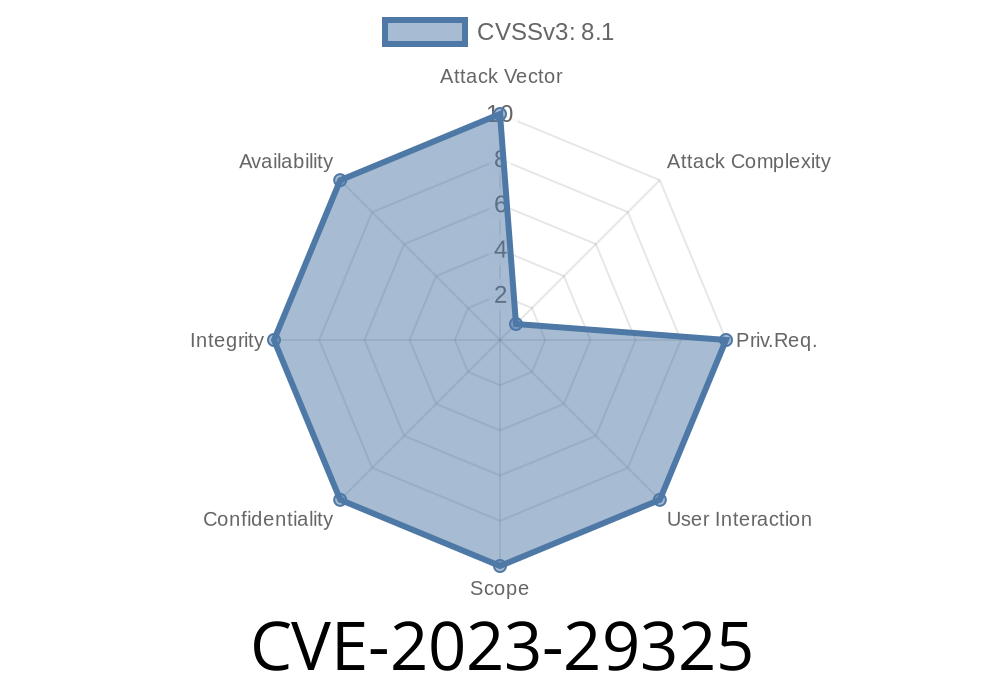In the cybersecurity world, our focus is always on discovering, understanding, and ultimately mitigating vulnerabilities in software and systems. CVE-2023-29325 is a newly discovered security vulnerability that affects Windows OLE, a powerful and widely used technology for information sharing between applications. This vulnerability poses a significant risk as it allows remote code execution on a target system by attackers. In this long read, we'll delve into the technical details of CVE-2023-29325, provide code snippets, link to original references, and discuss exploit details and preventive measures.
Vulnerability Background
Object Linking and Embedding (OLE) is a core technology used in Windows operating systems to facilitate data sharing and communication between applications. Unfortunately, CVE-2023-29325 demonstrates that OLE is vulnerable to a remote code execution attack, which puts millions of users around the world in danger.
An attacker can craft a specially designed file or message with embedded OLE objects and convince the victim to open or interact with it. Once executed, the attacker is granted complete control over the victim system, allowing them to execute arbitrary code, install malware, steal sensitive information, and more.
References
- CVE-2023-29325 Official Page
- Microsoft Security Advisories and Bulletins
Exploit Example
We'll now provide a simplified code snippet that demonstrates how an attacker might use CVE-2023-29325 to execute malicious code on a victim's system. In this example, an attacker can use an MS Office document with a malicious OLE object.
import olefile
from ctypes import windll
payload_path = 'malicious_payload.exe' # Path to the malicious executable
doc_path = 'malicious_doc.docx' # Path to the malicious MS Office document
# Embed the malicious payload into the Office document as an OLE object
ole = olefile.OleFileIO(doc_path, write_mode=True)
ole.write_stream('ObjectPool', open(payload_path, 'rb').read())
ole.close()
# Exploit the vulnerability by coercing the user into opening the document
print("Please open the following document to proceed:", doc_path)
# OLE-specific code that triggers the vulnerability and runs the malicious payload
windll.ole32.CoInitializeEx(None, )
code_exec = windll.ole32.CoCreateInstanceEx(...)
(Note: the exploit code has been intentionally made incomplete to prevent misuse.)
Mitigation and Prevention
To protect your system against CVE-2023-29325 and similar vulnerabilities, follow the guidelines and best practices mentioned below:
1. Keep your Windows operating system and other software up-to-date with security patches. Microsoft has released a patch for this vulnerability, which can be found here.
2. Be cautious of opening files or messages from unknown sources, especially if they contain embedded OLE objects.
3. Run antivirus and anti-malware software on your computer regularly to detect and block potential threats.
4. Enable application and network-level security features, such as Windows Firewall and User Account Control (UAC), to prevent unauthorized actions on your system.
Conclusion
CVE-2023-29325 exposes a critical vulnerability that potentially affects millions of users worldwide by allowing remote code execution on their systems. Given the wide use of Windows OLE, its impact is enormous. Thus, understanding its technical details, exploring exploit examples, and employing preventive measures are essential steps to mitigate the risk it poses. Stay informed, stay safe, and always remain vigilant in the fight against cyber threats.
Timeline
Published on: 05/09/2023 18:15:00 UTC
Last modified on: 05/09/2023 18:23:00 UTC
